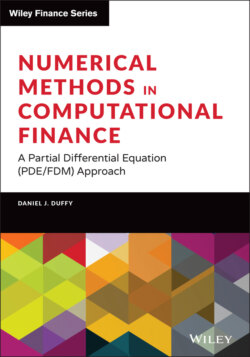Читать книгу Numerical Methods in Computational Finance - Daniel J. Duffy - Страница 70
4.2 WHAT IS A VECTOR SPACE?
ОглавлениеFrom Wikipedia:
In mathematics, a field is a set in which addition, subtraction, multiplication, and division are defined and these operators behave as the corresponding operations on rational and real numbers do. A field is thus a fundamental algebraic structure which is widely used in algebra, number theory, and many other areas of mathematics.
The best known fields are the field of rational numbers, the field of real numbers and the field of complex numbers.
In general, we use the symbol K to denote a generic field, but in most cases we work with real numbers as the underlying field in vector spaces. In some cases, complex numbers are used.
A vector space V over a field K (denoted by V(K)) is a collection of objects (called vectors) together with operations of vector addition and multiplication by elements of K (called scalars) satisfying the following axioms for addition of vectors:
(4.2)
Axiom A1 states that addition is associative, and axiom A2 states that addition is commutative. The element 0 is called the zero element of the vector space.
Scalar multiplication is defined by the axioms :
(4.3)
From these axioms we see that subtraction of vectors is possible because .
The prototypical examples of vector spaces are n-dimensional vectors and rectangular matrices over a field K:
(4.4)
For matrices:
(4.5)
We now define an important non-negative real-valued function on a vector space V called a norm. It has the following properties:
(4.6)
Some examples of norms for two-dimensional vectors are:
The following norms for vectors and matrices are used in applications:
(4.7)
(4.8)
Whereas the norm is a measure of the size of a vector, it is also possible to find the distance between two vectors. A natural way to proceed is, given a set X to define a real-valued function on called a metric that satisfies for :
A space X endowed with a metric d is called a metric space and is denoted by (X, d).
Examples of metrics are:
1
2 Let X be a non-empty set(4.9)
1 Let X be a set and let be the set of p-integrable Lebesgue functions on X. If , then a metric is:
Norms and metrics are important quantities when proving convergence results in functional and numerical analysis applications.
